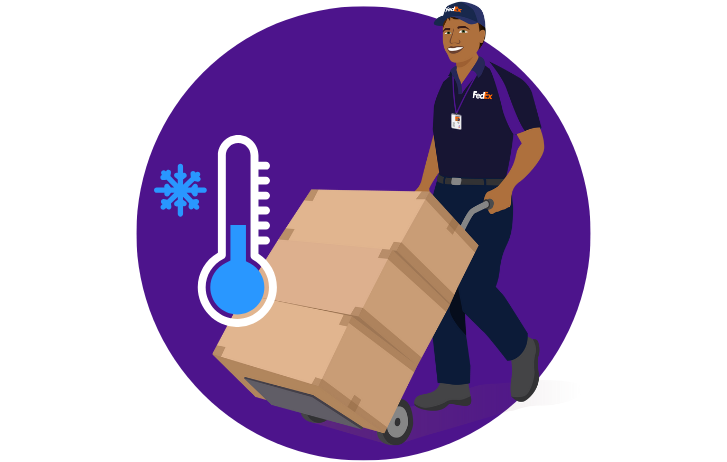
From Flowers To Frozen Foods: Difficult Items To Pack And How To Protect Them
By FedEx | First published: January 21, 2021 Updated: July 10, 2025
Rare and unusual items are shipped around the world every day – but packing them can be tricky. Discover top tips to help keep your fragile and sensitive packages safe.
- When shipping sensitive packages, a tailored approach works best.
- Some items call for temperature-controlled solutions, while others need extra cushioning.
- Keep these rules of thumb in mind: fill up the gaps, don’t overload, and do a drop test.
Not everything fits neatly into a box. How do you pack a delicate floral arrangement so that each dainty petal arrives intact? Or ship a piano made of 10,000 moving parts, which can go out of tune with the slightest jolt? How do you pack seafood to ensure it stays as fresh on arrival as it was on departure?
During Asia’s peak retail season, many such items make their way across the globe. Kicking off with Double 11 the previous November, the festive shopping season culminates in Lunar New Year – one of the busiest times for e-commerce and online orders.
As consumers send gifts and gear up for the festivities, e-commerce businesses across Southeast Asia and China will be busier than usual meeting shipping demands. From perishables like live fish to temperature-sensitive goods like wine, some of these items aren’t the easiest to ship.
We share the inside scoop on the most difficult items to pack, and how to make sure these sensitive packages are delivered safely.
1. When it comes to packing artwork, X marks the spot!
You can spot a great piece of art from a mile away – but do you know how to ship one safely? We often think of art as something static that hangs on walls, but it’s constantly on the move. From private collections and gallery exhibitions to public installations in hotels, restaurants, offices, and even train stations, art is everywhere. This means framed art is bought, sold and shipped all the time.
Shipping artwork safely to keep it in perfect condition is crucial, whether it’s a priceless painting or a piece with sentimental value. One simple tip? Apply masking tape in a criss-cross or large ‘X’ across the frame, from one corner to the other, to prevent splintering or cracks during transit.
Apply masking tape in a criss-cross or large ‘X’ across the frame, from one corner to the other, to prevent splintering or cracks.
At FedEx, we offer special packaging such as Premium Art Boxes, designed for high-value and fragile art shipments.
We also support many businesses globally that ship delicate items, such as Vietnamese brand Quilling Card, known for its intricate crafts and handmade items, and Elephant Parade, a Thai social enterprise that creates handcrafted elephant sculptures. These pieces are often intended as gifts, making protective packaging and careful shipping even more important.
2. Shipping flowers? Don’t leaf it to chance!
There’s a special joy in receiving a surprise flower delivery, especially when the blooms arrive fresh and flawless. But did you know that if flowers shift too much during transit, their stems and leaves can get damaged? This can spoil the appearance and lifespan of the gift. One of nature’s most fragile flowers – the orchid – also happens to be a seasonal favorite, especially around birthdays and Lunar New Year.
Orchids are hugely popular in Southeast Asia and China as symbols of luck and love in many cultures. But they’re not easy to transport. Contact between the plant’s blooms and leaves can lead to damage. To ensure safe shipping, always wrap the blooms and leaves in paper to provide extra cushioning.
Contact between an orchid’s blooms and leaves can lead to damage. Always wrap the blooms and leaves in paper to provide extra cushioning when shipping.
When shipping tropical flowers, temperature differences should be considered too – especially during colder months or when shipping to cooler climates. Make sure to use insulated or temperature-controlled packaging to protect the flowers from temperature drops during transit. As with all perishable items, try to avoid sending flowers on days that will require transit over a weekend or public holiday.
3. If you’re moving musical instruments, don’t play it by ear!
Musical instruments can be nerve-wracking to pack and ship. They’re highly sensitive to impact and temperature, and often hold both monetary and sentimental value for sellers and buyers.
Each type of instrument comes with its own quirks. Wind, string, and percussion instruments require different packaging techniques. Pianos, for example, feature 88 keys and over 10,000 moving parts, making them among the most complex instruments to pack and move.
Did you know that one of the most commonly shipped musical instruments is a guitar? Guitars have unique vulnerabilities that make proper packaging essential.
It’s important to loosen the strings before packing a guitar and to choose a climate-appropriate shipping method. This will relieve tension and reduce the risk of damage.
The strings, for example, create tension that can lead to damage during transit. Temperature changes can also cause the wood to expand and contract, affecting the tone and tempo. That’s why it’s important to loosen the strings before packing a guitar and to choose a climate-appropriate shipping method. This will relieve tension and reduce the risk of damage.
4. No need to flounder – shipping seafood is simple once you know how!
Ever wondered how seafood reaches your plate super-fresh – and as delicious as the day it was caught? Maintaining product integrity is critical for all edible goods, but seafood requires special care because it spoils so easily.
Shipping live seafood such as lobster or oysters? Use gel coolants. These won’t leak or cause any accidental freezing of your product.
Remember: different temperature-controlled solutions work for different types of refrigerated products.
Dry ice is a popular coolant, but you’ll need proper certification to comply with dangerous goods regulations. Due to excess weight and risk of leaks, we don’t recommend wet ice. Shipping live seafood such as lobster or oysters? Use gel coolants. These won’t leak or freeze your product.
5. Shipping bottles of the good stuff? Wine not check out our tips?
Imagine the life cycle of a good wine. The years spent growing the vines and tending the soil; the seasonal pruning and harvests; time aging in the cellar; and finally, bottling before being sold. But as any wine lover will tell you, decades of work can be quickly undone if a wine is improperly stored or shipped.
That’s because a cork-stoppered bottle of wine is a complex, temperamental mix of fermenting grapes, oxygen, and CO2 – and the contents are pressurized. Strict temperature control during shipping ensures the wine arrives in the best possible condition, ready to be enjoyed as intended.
In addition to considering temperature-controlled shipments, remember that wine is heavy. Only use boxes designed to hold a wine’s weight.
Proper wine shipping helps prevent damage to the quality of the wine as well as to the corks and bottles, which can deteriorate or corrode in extreme temperatures. This can happen in freezing aircraft holds or on hot airport tarmacs during transfers from plane to truck.
Our top tip? In addition to considering temperature-controlled shipments, remember that wine is heavy. Only use boxes designed to hold a wine’s weight. Shipping wine is also subject to customs regulations that vary by destination. Want to learn more about these requirements? Check out our Customs Tools guide for more information.
6. Shipping frozen foods? You’ve got to keep your cool.
From dumplings to meatballs, frozen foods have become a household staple for many. But when shipping them, simply sticking dry ice in a cardboard box won’t get the job done – these goods need strict temperature controls to prevent spoilage and bacterial growth.
Consider the maximum amount of time your shipment can safely stay in its packaging, and choose a shipping service that can deliver it at least 12 hours before that limit.
For starters, you’ll need an insulated box designed for shipping perishable items. Arrange coolants like gel packs or dry ice securely around your frozen goods, and line the box with absorbent, waterproof material to capture any liquid or condensation.
Consider the maximum amount of time your shipment can safely stay in its packaging, and choose a shipping service that can deliver it at least 12 hours before that limit.
7. Packing electronics? Don’t let it be game over.
If you’ve ever waited eagerly for 11.11 or Lunar New Year sales to snag the latest smartphone, you’re not alone. Electronics are a hot favorite for holiday shopping sprees, but no one wants to unbox their gizmo only to find damaged goods.
When packing electronics, wrap each component separately – chargers, cords, and other accessories – to prevent scratches or movement. Wrap fragile pieces snugly with bubble wrap, then enclose them in waterproof bags to keep them dry and dust-free. Finally, place everything in your shipping box and seal it off with tamper-evident tape.
If your shipment includes lithium batteries, you’ll need to comply with specific dangerous goods regulations too. Check out our guide to shipping lithium batteries for the right packaging and labeling requirements.
Get your sensitive packages delivered safely
When shipping rare, unusual, or sensitive items, there’s no doubt that the right packaging can make or break your delivery (literally). Here are three golden rules we like to keep in mind:
- Fill up empty spaces: When items shift around in transit, they’re more prone to damage. Pad any empty space with fillers like air pillows, and give your package a shake to check.
- Don’t overload: Going over the weight limit of your box can increase the risk of damage during shipping.
- Do a “drop test”: Verify how well your packaging method works by tossing your parcel around. Drop it, topple it, roll it. If your goods are temperature-sensitive, you can also test how well it withstands temperature changes.
For detailed, step-by-step instructions on packing different types of items, download our comprehensive guide here.
And don’t forget – our experts are here for you! If you have difficult items to pack and ship, contact us and we’ll be happy to help. Happy shipping!
SHARE THIS STORY
- 85% Of APAC Businesses Plan To Expand Into Europe, According To New FedEx Report
- Generative AI: A New Frontier
- How To Ship A Giant Panda
- The Rise Of Intra-Asia Trade: Opportunities In The China-Southeast Asia Corridor
- Where Do Old Planes Go When They Retire?
- What’s So Dangerous About Coconuts? Your Guide To Dangerous Goods Logistics
Sign up now and save on your shipping rates!
Sign up now and earn discounts by shipping instantly with FedEx Ship ManagerTM at fedex.com.
Recommended For You

Top 8 Most Unusual Things We’ve Ever Shipped: Part II
Whether rescuing animals in need or shipping priceless cultural artifacts, we have decades of experience moving highly rare items around the world.
Read More
8 Most Unusual Shipments In The History Of FedEx
From priceless artifacts to live animals, FedEx leverages its global network to ship rare and unusual items.
Read More
From Batteries To Chemicals: What You Need To Know About Dangerous Goods Logistics
Learn what qualifies as dangerous goods for shipping, how to ship them safely, and how FedEx solutions simplify dangerous goods logistics.
Read More







